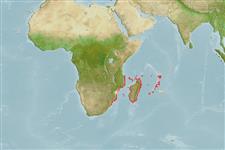Environment: milieu / climate zone / depth range / distribution range
นิเวศวิทยา
เกี่ยวกับทะเล,น้ำเค็ม เกี่ยวกับหินโสโครก; ระดับความลึก 12 - 15 m (Ref. 4395), usually 12 - 15 m (Ref. 4395). Tropical; 10°S - 29°S
Western Indian Ocean: South Africa, Comoros, and Mauritius.
ขนาด / น้ำหนัก / Age
Maturity: Lm ? range ? - ? cm
Max length : 6.0 cm TL เพศผู้/กระเทย; (Ref. 4395)
ก้านครีบอ่อนที่หาง (รวม) : 45 - 50; เงี่ยงครีบก้น: 0; ก้านครีบอ่อนที่ก้น: 36 - 40. Shoulder without the ocellated spot. Anterior interorbital pore absent. Preopercular canal with 6 pores. No scales on cheeks, opercles and nape. Gill membranes fused ventrally and free from isthmus.
Known from limestone and coral reefs.
Life cycle and mating behavior
Maturities | การสืบพันธุ์ | Spawnings | Egg(s) | Fecundities | ตัวอ่อน
Winterbottom, R., 1985. Revision and vicariance biogeography of the subfamily Congrogadidae (Pisces: Perciformes: Pseudochromidae). Indo-Pac. Fish. (9):34 p. (Ref. 531)
IUCN Red List Status (Ref. 130435)
Threat to humans
Harmless
Human uses
เครื่องมือ
Special reports
Download XML
แหล่งที่มาจากอินเตอร์เน็ต
Estimates based on models
Preferred temperature (Ref.
123201): 24.9 - 27.6, mean 26.6 °C (based on 173 cells).
Phylogenetic diversity index (Ref.
82804): PD
50 = 0.6250 [Uniqueness, from 0.5 = low to 2.0 = high].
Bayesian length-weight: a=0.00102 (0.00046 - 0.00225), b=3.06 (2.88 - 3.24), in cm total length, based on all LWR estimates for this body shape (Ref.
93245).
ระดับชั้นอาหาร (Ref.
69278): 3.8 ±0.61 se; based on food items.
Fishing Vulnerability (Ref.
59153): Low vulnerability (10 of 100).
